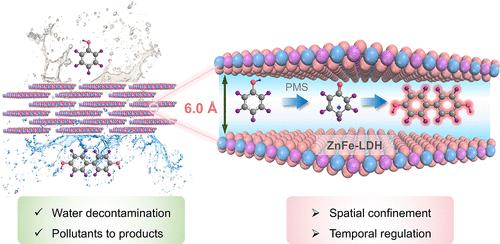酶激发埃限流系统中定向C-C耦合对水中酚污染物的升级回收
IF 11.3
1区 环境科学与生态学
Q1 ENGINEERING, ENVIRONMENTAL
引用次数: 0
摘要
将废水中的苯酚选择性转化为高附加值产品,为同时减少污染物和回收化学资源提供了一种可持续的策略。然而,由于开环降解、C-C / C-O偶联和聚合等竞争途径,传统氧化工艺的产物选择性较低。在这里,我们开发了一种使用层流膜纳米通道的埃限流动系统,以实现时空控制氧化和区域选择性C-C耦合。znfe层状双氢氧化物的6.0 Å层间距加强了苯氧自由基的立体选择性排列,而流动调制精确地调节了反应的进行。这种酶激发的双重控制策略在50%的苯酚转化率下实现了84%的C-C选择性,并抑制了传统批处理系统特有的寄生途径(C-O偶联,过度氧化)。力学研究和密度泛函理论(DFT)计算表明,纳米约束在热力学上稳定了对取向自由基,引导了无障C-C耦合。结合选择性树脂吸附双酚收获和苯酚回收,累计产品收率可达90%。这项工作为从受污染的水域中回收资源建立了一个低碳的污染物到产品的范例。本文章由计算机程序翻译,如有差异,请以英文原文为准。

Upcycling of Aqueous Phenol Pollutants via Directed C–C Coupling in an Enzyme-Inspired Angstrom-Confined Flow-Through System
Selective transformation of phenol in wastewater into value-added products offers a sustainable strategy for simultaneous pollutant abatement and chemical resource recovery. However, conventional oxidation processes suffer from low product selectivity due to competing pathways, including ring-opening degradation, C–C/C–O coupling, and polymerization. Here, we develop an angstrom-confined flow-through system using laminar membrane nanochannels to enable spatiotemporally controlled oxidation and regioselective C–C coupling. The 6.0 Å interlayer spacing of ZnFe-layered double hydroxide enforces stereoselective alignment of phenoxy radicals, while flow modulation precisely regulates the reaction progression. This enzyme-inspired dual-control strategy achieves 84% C–C selectivity at 50% phenol conversion and suppresses parasitic pathways (C–O coupling, overoxidation) that are endemic to traditional batch systems. Mechanistic studies and density functional theory (DFT) calculations reveal that nanoconfinement thermodynamically stabilizes para-oriented radicals, steering barrierless C–C coupling. Integrated with selective resin adsorption for biphenol harvest and phenol recycling, up to 90% cumulative product yield is achieved. This work establishes a low-carbon pollutant-to-product paradigm for resource recovery from contaminated waters.
求助全文
通过发布文献求助,成功后即可免费获取论文全文。
去求助
来源期刊

环境科学与技术
环境科学-工程:环境
CiteScore
17.50
自引率
9.60%
发文量
12359
审稿时长
2.8 months
期刊介绍:
Environmental Science & Technology (ES&T) is a co-sponsored academic and technical magazine by the Hubei Provincial Environmental Protection Bureau and the Hubei Provincial Academy of Environmental Sciences.
Environmental Science & Technology (ES&T) holds the status of Chinese core journals, scientific papers source journals of China, Chinese Science Citation Database source journals, and Chinese Academic Journal Comprehensive Evaluation Database source journals. This publication focuses on the academic field of environmental protection, featuring articles related to environmental protection and technical advancements.
 求助内容:
求助内容: 应助结果提醒方式:
应助结果提醒方式:


